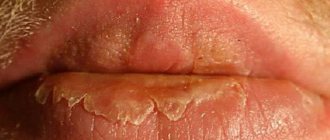A dry cough can be a symptom of many pathological conditions in the body, ranging from a mild cold to very serious diseases. If it occurs, you need to consult a doctor for a diagnosis.
Author:
- Galkin Alexey Vladimirovich
ENT pathology expert
3.33 (Votes: 15)
Coughing is a natural protective reflex of the body, a contraction of the chest muscles in response to the action of any irritant. Normally, it helps cleanse the mucous membranes of the respiratory tract from dust, mucus, and harmful microorganisms.
There are two types of cough: wet (productive) and dry (non-productive). In the first case, sputum is discharged, and the cough ultimately brings relief to the person. In the second, the cough is prolonged and painful, without sputum production, and is perceived by the person as much more painful. Most often, the disease begins with a dry cough, after which it transforms into a wet one, but sometimes this does not happen. A dry cough can be a symptom of many pathological conditions in the body - from a mild cold to serious illnesses. When it appears, even without signs of a cold or any other manifestations, you need to consult a doctor for a diagnosis. This will guarantee quick relief from dry cough, identification of the underlying disease or indication for lifestyle correction.
What you need to know about cough?
Any cough is not a pathology in itself, it is a consequence of certain disorders in the body. By nature, it is conceived as a kind of protective mechanism. When irritants or foreign bodies (including microscopic ones) enter the respiratory system, receptors begin to react, muscles contract, and we cough. In this way, the body tries to cleanse itself, and if it manages to do this on its own, there is no need for additional treatment.
With a rare, isolated cough, there is really no need to worry. Perhaps there is a lot of dust accumulated in the room or you have become hypothermic outside. But when it lasts more than seven days, even if there is no fever or other signs of illness, it is always a sign of illness. In this case, you should not limit yourself to traditional methods of getting rid of cough and delay going to the doctor. By eliminating a symptom, you do not solve the problem itself, and this is what is most important.
Correct examination for chronic cough
A cough lasting more than eight weeks is the reason for mandatory examination. In many of the above-mentioned diseases, cough may be the only sign of illness for some time. The examination should begin with a consultation with a therapist, who, if the most severe diseases (cancer, tuberculosis) have been excluded, will refer you to a specialized specialist - an otolaryngologist, gastroenterologist, or pulmonologist.
Examination for chronic cough includes instrumental and laboratory diagnostics depending on complaints and symptoms.
Laboratory diagnosis of the causes of prolonged cough:
- A CBC with a leukocyte formula will help identify acute and chronic bacterial, viral and allergic processes in the body.
- To diagnose helminthiasis, in which a protracted cough symptom complex often occurs: PARASEP stool test and blood test for antibodies to common parasites.
- To identify other causes of allergic cough: general immunoglobulin E and specific immunoglobulins to suspected significant allergens (respiratory or food).
- If helminthiasis and allergosis are excluded, a laboratory examination should be continued to look for the infectious nature of the cough: when sputum is discharged, it should be examined for culture to identify bacterial and fungal flora and DNA detection of intracellular microorganisms using the PCR method (mycoplasma, chlamyphylla, whooping cough, parapertussis).
- To detect tuberculosis, immunological tests are used, which are “in vitro” tests, i.e. is performed outside the body (in vitro), and therefore, unlike skin tests (Mantoux, Diaskin test), it does not require the introduction of provoking substances into the body. The test is based on assessing the T-cell immune response, namely, determining the release of interferon gamma by sensitized T-lymphocytes in peripheral blood.
With the results of the studies, it is necessary to contact a pulmonologist to make a diagnosis and choose further tactics of examination and therapy.
And in the LabQuest laboratory there is a special complex - Prolonged cough in a child, which includes most of the necessary tests.
The material was prepared by specialists from the LabQuest medical laboratory, which provides the entire range of laboratory diagnostics to children and adults.
Causes of cough without fever
Most often, when there is a cough without fever, we are talking about the following reasons:
- the development of viral and bacterial infections at the initial stage, when the rise in temperature has not yet begun (influenza, laryngitis, sinusitis, tonsillitis, pharyngitis, bronchitis, nasopharyngitis, etc.) or a latent, sluggish inflammatory process;
- an allergic reaction to various irritants that the body considers pathogenic and foreign (plant pollen, animal dander, mold, etc.). The immune system reacts to them, inflammation and cough appear accordingly;
- contact with the mucous membrane of smoke, dust or aerosols, resulting in mechanical or chemical irritation;
- entry of a foreign body into the respiratory tract when the body tries to remove it by coughing;
- residual manifestations of respiratory diseases, recently suffered or untreated;
- the development of various diseases that require special treatment (tuberculosis, thyroid dysfunction, lung cancer, emphysema, heartburn, heart failure);
- taking medications whose side effects are accompanied by coughing (pressure-lowering medications, etc.);
- various disorders of the mucous membrane and blood supply to the nasopharynx.
As you can see, there are a lot of options when there is no temperature and we start coughing. Without a comprehensive diagnosis, it is almost impossible to determine the cause in each specific case, so it is important when a cough appears to consult a specialist and undergo an examination. This is the only way to get rid of not only the symptoms, but also to overcome the root cause of their appearance.
Why can a runny nose be accompanied by a cough?
Features of the respiratory tract
.
Cough caused by respiratory infections is often accompanied by a runny nose. This is due to the fact that the human respiratory tract (nasal cavity, oro- and nasopharynx, larynx, trachea, etc.) is closely connected anatomically and functionally. Therefore, pathogens can easily spread from the upper respiratory tract to the lower and an “innocent” runny nose, left without treatment, can quickly lead to diseases such as laryngitis, pharyngitis, bronchitis, etc. Mechanical causes
.
When you have a runny nose, nasal discharge flows down the back wall of the nasopharynx, which irritates the mucous membrane and provokes a cough. Nasal breathing disorder
. When the nose is stuffy, a person is forced to breathe through the mouth, which can cause dryness of the throat mucosa, soreness and cough. In some cases, cough and runny nose may be unrelated symptoms, but this does not eliminate the need for their treatment.
Cough in adults
In adults, any of the above reasons may occur. In addition, the so-called smoker's cough is common. With constant inhalation of nicotine, hot smoke and harmful substances, the mucous membrane of the respiratory tract becomes irritated. As a result, the smoker begins to suffer from a dry cough, but without fever or other symptoms of other diseases. At the same time, long-term smoking can lead to inflammatory reactions in the bronchi, and this is a disease that requires medical intervention.
You can also develop an unreasonable cough due to stressful situations, inhalation of cold air, or prolonged exposure to a room where the air is dry or, conversely, humid. In such cases, we are not talking about the symptoms of the disease, but about the natural reaction of the body. You can get rid of a cough only by eliminating the source of exposure (quit smoking, use a humidifier, get out of a stressful situation).
Doctor MOM® preparations for the treatment of cough
The composition of the Doctor MOM® line of drugs includes natural essential oils and extracts of medicinal plants in carefully selected proportions. The combined use of syrup and Doctor MOM® lozenges facilitates the removal of infection from the body2 and helps eliminate the inflammatory process - the cause of cough. Ointment Doctor MOM® Phyto can be used not only to relieve nasal congestion, but also to eliminate headaches and muscle pain - frequent companions of upper respiratory tract diseases.
During pregnancy
If there is no fever during pregnancy, a cough may be caused by hormonal changes. When the entire body is rebuilt, it becomes a temporary phenomenon and, as a rule, does not cause as much harm as other diseases. However, even a hormonal cough should not be neglected. The reasons for it, of course, cannot be eliminated, but they need to be mitigated. Constant contraction of the abdominal muscles when coughing leads to contraction of the ligaments. And the most unfavorable consequences of this are the appearance of bleeding and premature birth.
It is better to refuse drug treatment for cough during pregnancy and give preference to traditional medicine. However, you should not drink anything on your own, even seemingly harmless herbal teas. They are allowed to be taken only after consultation with your doctor, because all substances that enter the body of a pregnant woman affect the health and proper development of the fetus.
1.General information
Cough is a spastic, repeated contraction of the muscles associated with the respiratory tract. The natural purpose of such a reflex, which most often occurs in response to irritation of the ENT organs and structures of the respiratory system, is to forcefully cleanse the lumen of the airways. A distinction is made between dry (unproductive) and wet cough (productive, colloquially “wet”, “expectorant”, i.e. accompanied by the separation of mucous masses).
Often there is a transformation of a dry cough into a wet one and vice versa.
In general, a persistent, clearly pathological cough is one of the most common reasons for seeking medical help (according to Western data, from 10 to 40 percent of all visits to the doctor are caused by a cough as the only complaint). In this case, dry cough is more common; For patients, it is more uncomfortable, often painful, debilitating and difficult to treat. There are many reasons and factors that cause such conditions; in some cases, these causes are found outside the respiratory system or nasopharynx. Thus, dry cough remains an acute problem for several areas of modern medicine.
Sign up for a consultation
A must read! Help with hospitalization and treatment!
What could a cough be like?
Its appearance plays an important role in diagnosing cough and combating it. You can also cough in different ways, which reduces the list of possible causes in a particular case and determines the features of further treatment of the disease.
In this regard, we may encounter a cough:
- dry (sometimes with wheezing) and wet (accompanied by sputum production). Dry is more characteristic of allergic manifestations, reactions to dust, smoke, dry air, it accompanies heart disease, and wet - colds, bronchitis, tuberculosis and similar diseases;
- paroxysmal (a person suffocates and feels severe discomfort in the throat). This cough is most often encountered with asthma, smoking, and chronic diseases of the respiratory system. It often changes from dry to wet;
- long-term, which does not go away within a month or longer - asthma, whooping cough, chronic bronchitis, smoking, enlarged thyroid gland;
- deep, which is a sign of allergies and respiratory diseases, tumors;
- rare and short-term, which most often shows the impact of provoking factors at a given moment in time - high/low humidity, fungus, the presence of an allergen, toxins in the air;
- purulent, indicating a severe bacterial infection;
- with a sore throat, when coughing itself also causes pain.
This means that the pain receptors of the mucous membrane are irritated (sore throat, pharyngitis, laryngitis) or the mucous membrane itself is damaged.
Pay attention to what kind of cough you have, try to determine what it looks like. The doctor will definitely ask about this during the appointment, especially if during the entire time you were in his office you never coughed. This classification, together with other symptoms and diagnostics, allows an accurate diagnosis to be made.
List of inflammatory diseases
Certain diseases provoke the occurrence of a dry, non-productive cough. The main list is presented:
- Tracheitis - an inflammatory process of the trachea occurs when a viral, staphylococcal, or streptococcal infection penetrates. The condition is affected by polluted or cold air; patients experience morning coughing attacks and fever. The pathology can be combined with bronchitis or pharyngitis.
- Laryngitis – inflammation in the larynx area leads to voice disturbance, painful swallowing, and fever. Cough during the disease is considered painful and convulsive.
- Pneumonia - determined by pain in the chest, during breathing, shortness of breath and temperature. Accompanied by scanty, poorly separated sputum. When a bacterial infection occurs, the purulent mucous secretion turns green.
- Whooping cough is a childhood pathology with a complex course in adults. It is characterized by a series of strong coughing impulses, with the separation of vitreous secretions, an attack of vomiting, cyanosis, and sometimes loss of creation.
- Tuberculosis - a disease that causes specific inflammation of tissues, with decay and the formation of cavities in the lungs. A prolonged, muffled cough causes mucous or purulent discharge; when the larynx and bronchi are affected, it becomes paroxysmal.
With pharyngitis, patients suffer from a painful and dry cough reflex. At the same time, they have difficulty swallowing and have a low-grade fever of up to 37.5 degrees. Bronchitis and chronic obstructive pulmonary disease are also included in the list of pathological processes with severe cough.
Possible treatment
As for the treatment of any cough, it is complex. Some of the measures taken are aimed at making coughing easier, and some are aimed at eliminating the cause of this phenomenon.
The treatment regimen is always individual and prescribed by the doctor after a complete diagnosis of the patient with examination and tests. As a rule, drugs used to eliminate fever-free cough can be divided into several groups:
- antitussives;
- thinning;
- antihistamines (antiallergic);
- antifungal;
- antibacterial (antibiotics);
- antiviral.
The choice of specific medications depends on the reasons why the cough appeared and should only be carried out by a specialist.
Additionally, rinses and inhalations with medicinal herbs and oils (eucalyptus, menthol, chamomile, lavender, string, sage, echinacea) may be prescribed.
What to do if the cough does not go away for 2 weeks or more
The doctor will tell you how to treat a dry cough that does not go away for a long time after making an accurate diagnosis. Different medications are indicated for different diseases:
- If a prolonged cough is caused by allergies or bronchial asthma, bronchodilators (Salbutamol, Berodual) and antihistamines (Suprastin, Zyrtec, Loratadine) are prescribed.
- Treatment of inflammatory and infectious diseases, including tuberculosis, is carried out with fluoroquinolone antibiotics (Norfloxacin, Levofloxacin, Palin).
- For respiratory failure, which occurs against the background of a severe cough, the use of Prednisolone or other corticosteroids is required.
- If the cough does not stop due to diseases of the respiratory tract, antitussive medications are prescribed (Stoptussin, Sinekod).
- To liquefy and expectorate secretions, mucolytic expectorant drugs (Mukaltin, ACC) are prescribed.
- Depending on the type of pathology, antiviral drugs (Kagocel, Ingavirin) are also taken.
Inhalation with a nebulizer helps to eliminate a cough that does not go away for a long time.
The doctor also selects solutions based on the type of cough (Gerbion, Atrovent, Pulmicort, mineral water).
With the doctor's permission, you can take folk remedies - milk with honey, black radish juice with honey, herbal decoctions.
Useful tips
To help the body overcome the disease and eliminate its symptoms, following a few simple tips (in addition to the treatment regimen, and not instead of it):
- try to breathe exclusively through your nose so as not to irritate the mucous membranes of your throat;
- drink more still water and warm liquids (milk with butter and honey, rose hip, licorice and marshmallow tea, with raspberries, viburnum, sea buckthorn, ginger);
- humidify the air in the room where the cough sufferer is located and walk in the fresh air;
- do inhalations (the old fashioned way over a pan of steam or using a special nebulizer);
- do not speak loudly or scream - this is completely unacceptable when coughing and will only aggravate the situation;
- carry out warming procedures for your hands and feet.
It is important not to interrupt the treatment process until the cough is completely defeated, and not to stop halfway. Even if you feel much better, this does not mean that the disease is completely defeated. Untreated diseases can lead to serious consequences in the form of complications, so contact the specialists of the MedCom network of clinics in a timely manner.
When should you see a doctor?
The presence of the symptoms themselves (cough and runny nose) is a sufficient reason to consult a doctor. However, there are a number of symptoms that accompany a runny nose and cough, in which you should consult a doctor as soon as possible. These include:
- high body temperature, which cannot be reduced with conventional antipyretics;
- acute pain in the ears, throat;
- difficulty breathing, difficulty swallowing;
- loss of voice or severe hoarseness;
- coughing up excessive amounts of sputum, detecting traces of pus and blood in it;
- the appearance of acute pain in the chest and/or back during a strong cough.










